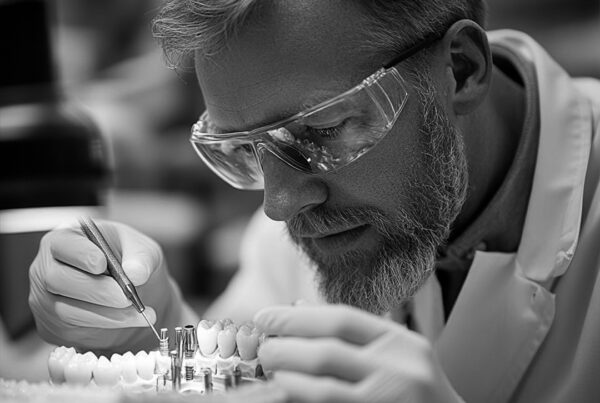
All-on-Four implant treatment is a harmonious tooth fusion method developed for individuals who are completely edentulous or have suffered extensive tooth loss. This technique allows you to archive a complete tooth into the jawbone using only four implants. All-on-Four allows patients to treat more teeth with fewer implants, making the treatment process both faster and more cost-effective.
The basic record of All-on-Four treatment is that four implants are placed in the strongest fixed areas of the jawbone, providing a prosthetic tooth on top. Two implants are placed in the anterior part of the jaw and the other two implants are placed at an angle in the posterior part. This angled installation system provides the advantage of making the best use of the existing bone structure and requiring less bone. This method also shortens the time required for the implants to fuse.
The treatment process begins with an assessment of oral and dental health. The dentist examines the jaw protocol, gum health and general health symptoms. Using the necessary imaging methods, the parts to be implanted are manipulated. At this stage, a customized treatment plan is created for the individual.
Another important advantage of All-on-Four treatment is that after the procedure, patients can usually access their teeth with a temporary denture on the same day. This allows patients to experience a rapid aesthetic and functional recovery process. The permanent prosthesis was placed a few months later after the fusion of the implants with the jaw foam was completed.
All-on-Four implant treatment has many advantages. First of all, it uses fewer implants, shortens the surgical period and accelerates the healing process. It also helps to preserve the jaw structure for a long time by preventing the jaw from melting. This method provides great comfort and safety in cases of tooth loss, especially in age correction instructions.
However, All-on-Four implant treatment has some crises. It may not be suitable for every patient; it is important to have sufficient bone volume and healthy gum structure. Furthermore, the success rate of the treatment process may vary depending on the overall health status and oral hygiene offered.
In conclusion, All-on-Four implant treatment offers a reliable and effective solution for completely edentulous individuals. This method offered by modern dentistry aims to extend the lives of patients both aesthetically and functionally. With the right assessments and the guidance of specialized dentists, patients are provided with a long-lasting and natural smile.
Advantages of All on Four Treatment
- Full Dental Arch with Few Implants: Placing a fixed dental arch in the upper or lower jaw with just four implants speeds up the treatment process and reduces costs.
- Fast Recovery Process: Most patients can have their teeth restored with temporary dentures the same day after the implants are placed, allowing for a quick turnaround.
- Bone Preservation: Implants help prevent jawbone resorption and preserve the jaw structure in the long term.
- Less Surgical Intervention: Requiring fewer surgical procedures than other methods increases both the duration of the procedure and the comfort of the patient.
- Less Recovery Time: The recovery period after the placement of teeth is usually short, which allows patients to return to their daily lives quickly.
- Natural Look and Feel: Teeth placed with All-on-Four treatment look similar to natural teeth and often feel natural.
- Less Tooth Loss: Implants protect oral health by preventing the loss of surrounding teeth.
Disadvantages of All on Four Treatment
- Adequate Bone Structure Requirement: Not all patients may have sufficient jawbone, which may make implant placement difficult or impossible.
- Cost: All-on-Four treatment may be more costly than other treatment methods and may not be covered by insurance.
- Pain and Discomfort: Mild pain or discomfort may be experienced after the surgical procedure, but this can usually be controlled with painkillers.
- Need for Long Term Care: Regular dental check-ups and good oral hygiene are necessary for the longevity of implants.
- Poor Aesthetic Results: In some cases, aesthetically satisfactory results may not be achieved, especially if there are significant changes in the structure of the mouth.
10 Frequently Asked Questions
- How long does the All-on-Four treatment take?
- Implant placement usually takes 1-2 hours, but the healing process can take several months.
- Are the implants painful?
- The procedure is performed under local anesthesia, so there is no pain during the procedure. There may be some mild discomfort afterwards.
- Who can undergo All-on-Four treatment?
- Most adults with sufficient bone volume and in good general health.
- How long do implants last?
- With proper care, they can last 10-15 years or longer.
- What should be considered after All-on-Four treatment?
- You should pay attention to oral hygiene and have regular dental check-ups.
- Who is All-on-Four treatment not recommended for?
- It may not be recommended for people with excessive gum disease, serious systemic diseases or insufficient bone structure.
- What kind of diet is recommended during the treatment process?
- It is recommended to prefer soft and light foods after the procedure.
- Is there a risk of failure in All-on-Four treatment?
- Yes, there is a risk of failure. However, the success rate is quite high in appropriate patients and when well applied.
- Which foods should not be eaten after implant treatment?
- Hard, sticky or extremely hot foods should be avoided.
- Is implant treatment covered by insurance?
- Most insurances may not cover implant treatment, so it is important to check your policy.















